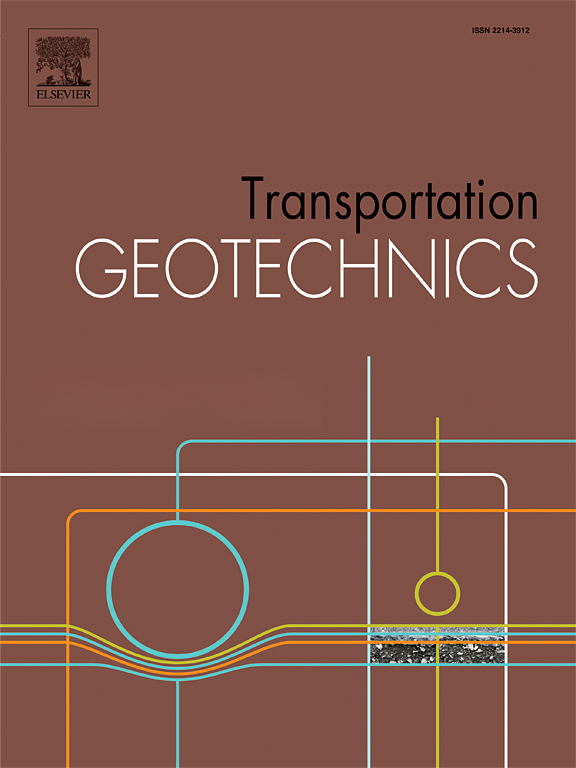Performance evaluation of longer crossties in railroad track transition zone: Finite element analysis and laboratory experimentation
IF 4.9
2区 工程技术
Q1 ENGINEERING, CIVIL
引用次数: 0
Abstract
Transition zones in railway tracks are characterized by abrupt changes in the track stiffness which induces differential track displacement and can result in settlement. Failure to promptly address these issues through maintenance activities can lead to accelerated track component degradation and a loss of passenger comfort. This study investigated the effectiveness of a conventional strategy involving the implementation of longer crossties to mitigate abrupt variation of track stiffness especially in the open track to bridge transition. The study initially explored various properties and layouts of elastomers (i.e., rubber pads) through finite element analysis (FEA) to determine the appropriate support condition as an alternative to ballast to ensure consistency across the tests. Different hardnesses and configurations of rubber pads were considered to replicate the behavior of the ballast, and a dual layer of 60 shore A rubber pads with 25 holes exhibited crosstie displacement of 0.16 in. (0.41 cm), aligning with the range of field data. Based on this selected support condition, three different crosstie lengths (i.e., 102 in. [259 cm], 132 in. [335 cm], and 168 in. [427 cm]) were evaluated through both FEA and laboratory experimentation. Modeling results showed a 4.2 % reduction in displacement under the rail seat for the 168 in. (427 cm) crosstie compared to the standard crosstie (i.e., 102 in. [259 cm]). Similarly, laboratory experimentation demonstrated an 8.2 % decrease in vertical rail displacement. These findings suggest that the implementation of longer crossties within the track transition zone may not be considered an ideal methodology for achieving a gradual increase in track stiffness.
铁路轨道过渡区较长十字路口性能评价:有限元分析和实验室试验
轨道过渡带的特点是轨道刚度的突变,从而引起轨道位移的差异,并可能导致沉降。如果不能通过维护活动及时解决这些问题,可能会导致轨道部件加速退化,并失去乘客的舒适度。本研究探讨了一种传统策略的有效性,包括实施更长的交叉,以减轻轨道刚度的突然变化,特别是在开放轨道到桥梁的过渡。该研究最初通过有限元分析(FEA)探索了弹性体(即橡胶垫)的各种特性和布局,以确定适当的支撑条件作为镇流器的替代方案,以确保测试的一致性。考虑了不同硬度和配置的橡胶垫来复制压舱物的行为,并且具有25个孔的60个双层shore a橡胶垫的横向位移为0.16 in。(0.41 cm),与现场数据范围对齐。在此选定的支撑条件下,三种不同的交叉长度(即102 in。[259厘米],132英寸[335厘米]和168英寸。[427 cm])通过有限元分析和室内实验进行了评价。建模结果显示,168英寸的导轨座下的位移减少了4.2%。(427厘米)的横截面与标准横截面(即102英寸)的横截面相比。(259厘米)。同样,实验室实验表明,垂直轨道位移减少8.2%。这些发现表明,在轨道过渡区内实施较长的交叉可能不被认为是实现轨道刚度逐渐增加的理想方法。
本文章由计算机程序翻译,如有差异,请以英文原文为准。
求助全文
约1分钟内获得全文
求助全文
来源期刊

Transportation Geotechnics
Social Sciences-Transportation
CiteScore
8.10
自引率
11.30%
发文量
194
审稿时长
51 days
期刊介绍:
Transportation Geotechnics is a journal dedicated to publishing high-quality, theoretical, and applied papers that cover all facets of geotechnics for transportation infrastructure such as roads, highways, railways, underground railways, airfields, and waterways. The journal places a special emphasis on case studies that present original work relevant to the sustainable construction of transportation infrastructure. The scope of topics it addresses includes the geotechnical properties of geomaterials for sustainable and rational design and construction, the behavior of compacted and stabilized geomaterials, the use of geosynthetics and reinforcement in constructed layers and interlayers, ground improvement and slope stability for transportation infrastructures, compaction technology and management, maintenance technology, the impact of climate, embankments for highways and high-speed trains, transition zones, dredging, underwater geotechnics for infrastructure purposes, and the modeling of multi-layered structures and supporting ground under dynamic and repeated loads.
 求助内容:
求助内容: 应助结果提醒方式:
应助结果提醒方式:


